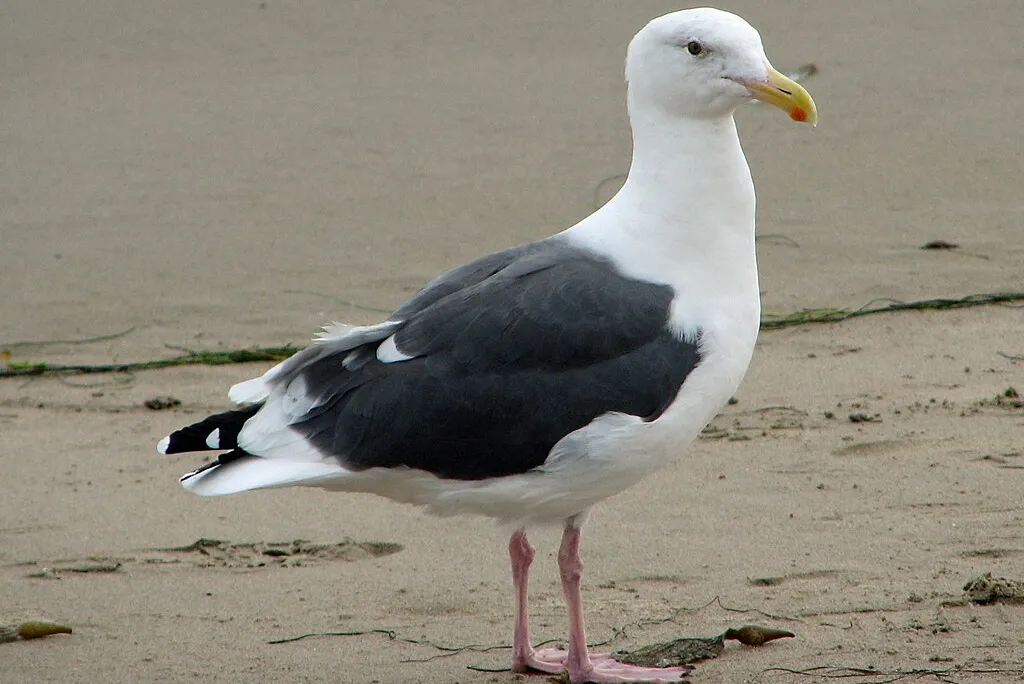A California Gull Hitched a Ride on a Garbage Truck and Took an 80-Mile Journey to a Compost Facility. Then It Happened Again
GPS tracking data showed the bird zooming across bridges and interstates at 60 miles per hour on two occasions in 2018

Scott Shaffer was reviewing the data from a GPS tracking device he had attached to a western gull when he noticed something unusual: The bird had been traveling 60 miles per hour, suspiciously faster than the species’ typical flying speed of 20 miles per hour.
When the San Jose State University biologist took a closer look at the gull’s route, he saw the bird had zoomed along major roadways, eventually arriving at an outdoor composting facility roughly 80 miles away from where it started. Two days later, the gull made the same journey.
But why? And how? Shaffer and his colleagues have concluded the bird hitched back-to-back rides on a garbage truck, taking advantage of the low-effort form of transportation to reach a destination filled with tasty food scraps.
Their May 29 paper in the journal Waterbirds describing the unusual behavior provides the first GPS observation of a western gull (Larus occidentalis) riding an 18-wheeler to a compost facility.
“It was surprising and comical, so much so that we wanted to look closely into this one individual’s behavior to understand how this happened,” says lead author Megan Cimino, a biologist at University of California, Santa Cruz, to Axios’ Nadia Lopez.
Did you know? Migrating birds may rest on ships
Some evidence suggests that migratory birds might use boats in the Mediterranean Sea as rest areas to take a much-needed break from their travels, especially during severe weather conditions.
The gull made its pioneering journeys back in May 2018. Shaffer first encountered the female that spring as she was nesting on the Farallon Islands, a group of rocky outcroppings in the Pacific Ocean west of San Francisco. The islands are home to large breeding colonies of seabirds, and Shaffer was there conducting research on the western gulls’ diet, habitat use and foraging techniques.
After gently capturing the gull in a pillowcase, Shaffer affixed a small, lightweight GPS tracking device to her tail, reports SFGate’s Amanda Bartlett. He returned a week later to collect the device so he could analyze the data.
A female Western Gull was recorded riding 150km in a garbage truck from San Francisco to a compost facility in Central CA, probably to forage. TWICE. An innovator, an icon, a genius. This is one of my favorite @waterbirdsociety.bsky.social papers I've ever handled as managing editor #ornithology
— Paige Byerly, PhD (@paigebyerly.bsky.social) June 3, 2025 at 2:24 AM
[image or embed]
According to the tracking device, the gull left the Farallon Islands and flew to San Francisco on May 21, 2018. Once there, the bird visited a garbage and recycling transfer station run by the company Recology.
Then, the gull traveled across the San Francisco–Oakland Bay Bridge, cruised along Interstate 880 and ventured down Highway 580. Her final destination was a composting facility near Modesto, where she spent the night. The next day, the gull flew back to the Farallon Islands.
Then, on May 23, 2018, the bird returned to the composting facility—only, this time, she took a different route, traveling along the San Mateo-Hayward Bridge.
The two trips took 14 to 18 hours longer, on average, than the other journeys the gull took during the week-long tracking period, according to the paper. They were also 59 to 81 miles farther from the colony, on average.
Researchers suspect the gull made the first trip accidentally, after becoming trapped under a mesh-like tarp placed atop Recology’s 18-wheel garbage trucks to prevent food scraps from spilling out in transit. The gull may have been feasting on the truck’s load as the unsuspecting driver made preparations to hit the road.
But as for the second time the gull made the trip? That’s a mystery.
One possibility is that the gull realized she’d found a reliable food source, so she decided to try her luck aboard a garbage truck for a second time. Researchers have tracked other gulls returning to the same urban food sources again and again, such as a dumpster behind a deli.
“Gulls are smart,” said Cheryl Strong, a biologist formerly with the Don Edwards San Francisco Bay National Wildlife Refuge who was not involved with the research, to the Mercury News’ Paul Rogers in July 2018. “Maybe this bird will take its kids there and say, if you get in this truck, you can get better food somewhere else.”
But riding a truck 80 miles—twice in the same week—is a lot different than flying to a nearby dumpster, so the scientists really don’t know what the gull was doing. As they write in the paper, “the bird’s intentions are difficult to establish.”
For now, the truck-riding gull seems to be an anomaly. But, the researchers add, this type of behavior could become more common as birds and other animals search for new food sources amid changing ocean and climate conditions.
Gulls may be “a nuisance if you’re having a picnic on the beach,” Shaffer tells SFGate, “but [they] can tell us a lot about the health of our environment right offshore from San Francisco.”
/https://tf-cmsv2-smithsonianmag-media.s3.amazonaws.com/accounts/headshot/SarahKuta.png)
